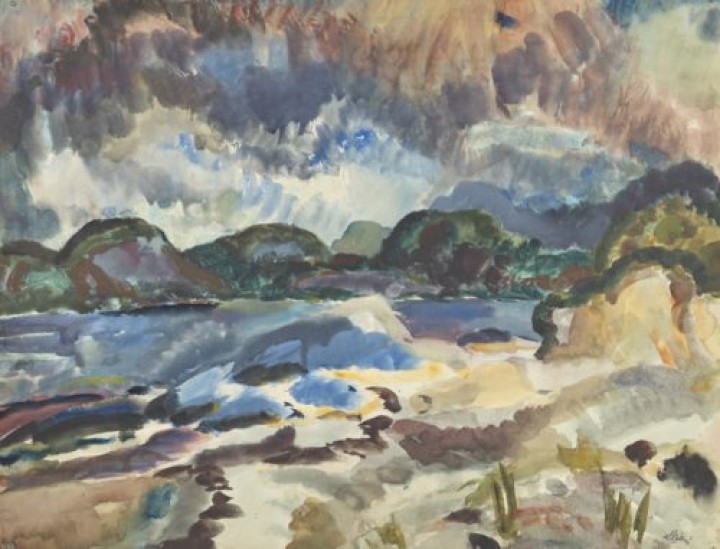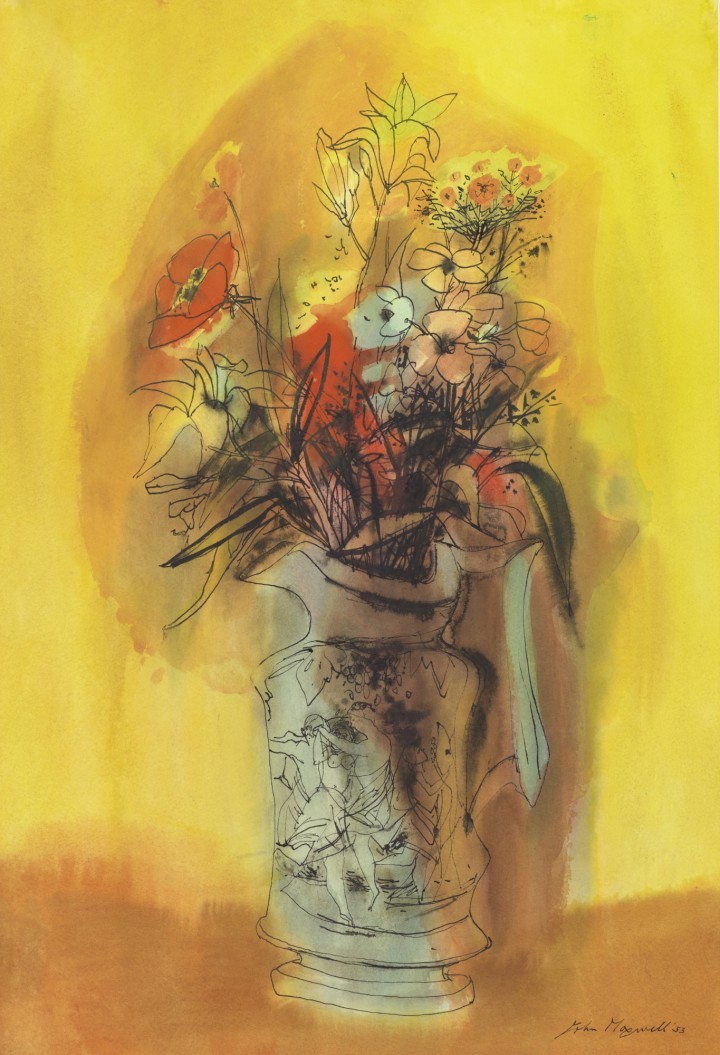Scottish Art News
Latest news
Magazine
News & Press
Publications
William Gillies & John Maxwell
By Helen Scott, 01.05.2016

When I joined the City Art Centre in summer 2013 as curator of Fine Art, one of my first priorities was to familiarise myself with the collection. The centre holds over 4800 artworks in a variety of media, which trace the development of Scottish art from the 17th century to the present day. Looking through the oils, watercolours, prints, sculptures and installation pieces in storage, I was struck by the number of works by William Gillies (1898–1973) and John Maxwell (1905–62), two members of the loose group known as the Edinburgh School. I subsequently learned that many of these paintings and drawings were part of the Fletcher Collection, a set of 43 works by Gillies and Maxwell that had been on long-term loan to the City Art Centre since 1995.
The Fletcher Collection was amassed by botanist Dr Harold R Fletcher and his wife Mrs Elizabeth ‘Betty’ Fletcher, who began collecting in the 1940s. Although they bought work by a number of Scottish artists, including Anne Redpath (1895–1965), Robin Philipson (1916–92) and William Littlejohn (1929–2006), Gillies and Maxwell were personal friends and particular favourites. Dr Fletcher passed away in 1978, and, in the early 1990s, his family approached the City Art Centre with a view to lending the majority of the collection, 18 works by Gillies and 25 by Maxwell, on a long- term basis. The Fletcher Collection arrived in 1995 and went on display later that year. Following that time, individual pieces and subsets of the collection were featured in the temporary exhibition programmes and touring shows. Yet, the works were never again displayed en masse – a situation that I was keen to rectify.
So this summer the City Art Centre stages ‘William Gillies & John Maxwell’, the first exhibition in over 20 years to showcase the Fletcher Collection in its entirety. The show follows the parallel development of the two artists as their careers and personal lives interwove throughout the middle decades of the 20th century. Over 70 artworks are included, with the Fletcher Collection augmented by a selection of works from the City Art Centre’s own permanent collection, and additional pieces on loan from the Royal Scottish Academy of Art & Architecture and the University of Edinburgh Art Collection. Displaying Gillies and Maxwell side by side, the exhibition gives audiences the opportunity to explore not only the output of these two significant artists, but also the legacy of their enduring friendship.
It is thought that Gillies and Maxwell first met in the early 1920s, when Gillies was completing his training at Edinburgh College of Art and the younger Maxwell had just embarked on his studies there. Both artists pursued comparable paths at the outset of their careers. Having gained his postgraduate diploma in 1923, Gillies used a travelling scholarship to spend time in Paris working under Cubist painter André Lhote (1885–1962). After five months, he moved on to Italy where he visited museums and churches, and sketched the local sights. Three years later, Maxwell followed a similar route, studying at the Académie Moderne in Paris under Fernand Léger (1881–1955) and Amédée Ozenfant (1886–1966), before progressing on to Spain and Italy. By 1929, both men had returned to Edinburgh College of Art to join the teaching staff.
The two artists had contrasting personalities and different approaches to their work. Gillies’ manner was quiet and retiring, but his seemingly boundless energy made him a prolific painter. Maxwell was the more gregarious of the pair, although he was notoriously self-critical and laboured extensively over many of his compositions. In spite of these differences, or perhaps because of them, a close friendship developed over the years.
 John Maxwell, Yellow Flower Piece, 1953. The Fletcher Collection. Courtesy of the Maxwell Family.
John Maxwell, Yellow Flower Piece, 1953. The Fletcher Collection. Courtesy of the Maxwell Family.
From the late 1920s onwards, Gillies and Maxwell undertook regular painting holidays together, leaving the responsibilities of college life in Edinburgh to explore the landscapes of rural locations like Dumfriesshire, the North West Highlands and the East Neuk of Fife. They usually camped on these excursions, sometimes in the company of others, such as Gillies’ younger sister, Emma, a talented ceramicist. The pair also made trips abroad; for example, in 1937 they visited the Exposition Universelle in Paris. During term-time they socialised together, attending supper parties and college functions. Eventually, they both moved away from Edinburgh, with Gillies relocating to the Midlothian village of Temple in 1939 and Maxwell returning to his native Dalbeattie in 1946, but they still continued to visit each other often.
Maxwell’s teaching career at Edinburgh College of Art was more intermittent than Gillies’ tenure. The younger artist took a two-year break in 1933 and resigned completely in the mid-1940s, before being persuaded to rejoin the staff body in 1955. Gillies remained at the college for over 40 years, ultimately advancing to the position of principal. Throughout this period, they exhibited together, showing work at the Society of Scottish Artists and the Royal Scottish Academy. In 1950, both men were invited to participate in the Festival of Britain exhibition ‘Sixty Paintings for ’51’, a high-profile event intended to showcase the best of British contemporary art. Through teaching and public displays of their work, they exerted a considerable influence on the next generation of Scottish painters.
In 1962, Maxwell’s premature death had a profound effect on Gillies. As he later wrote: ‘I knew him intimately, I valued his friendship, his unaffected manner, his essential simplicity, his whimsical humour; above all his amazing gifts as an artist. His death has left a void which can never wholly be removed.’ Although Gillies was a popular teacher and successful painter, he was a very private man who led a largely compartmentalised life. He embraced few friends as closely as his immediate family, but Maxwell was counted among those exceptional few.
As artists, Gillies and Maxwell matured in different creative directions. Gillies is best known for his tonal landscapes of the rolling Borders countryside, his spontaneous Highland watercolours and his carefully constructed still-life compositions. Meanwhile, Maxwell is remembered for his expressive, often dream-like depictions of creatures, flowers and timeless nudes; the heavily worked oils and joyous watercolours that flowed from his imagination. Yet, there were points of creative crossover in their work and they sometimes drew from the same influences, such as their early encounters with the paintings of Edvard Munch (1863–1944) and Paul Klee (1879–1940). Presenting the two artists in tandem helps us better understand these commonalities and differences.
This exhibition, with the Fletcher Collection at its heart, brings together many of the artists’ finest drawings and paintings, alongside photographs and other archival objects. Timed to coincide with the Edinburgh Art Festival, ‘William Gillies & John Maxwell’ is a chance to re-examine and celebrate the achievements of this unique pairing.
Dr Helen Scott is curator of Fine Art at Edinburgh’s City Art Centre | William Gillies & John Maxwell was exhibited at the City Art Centre between 30 July–23 October 2016.




